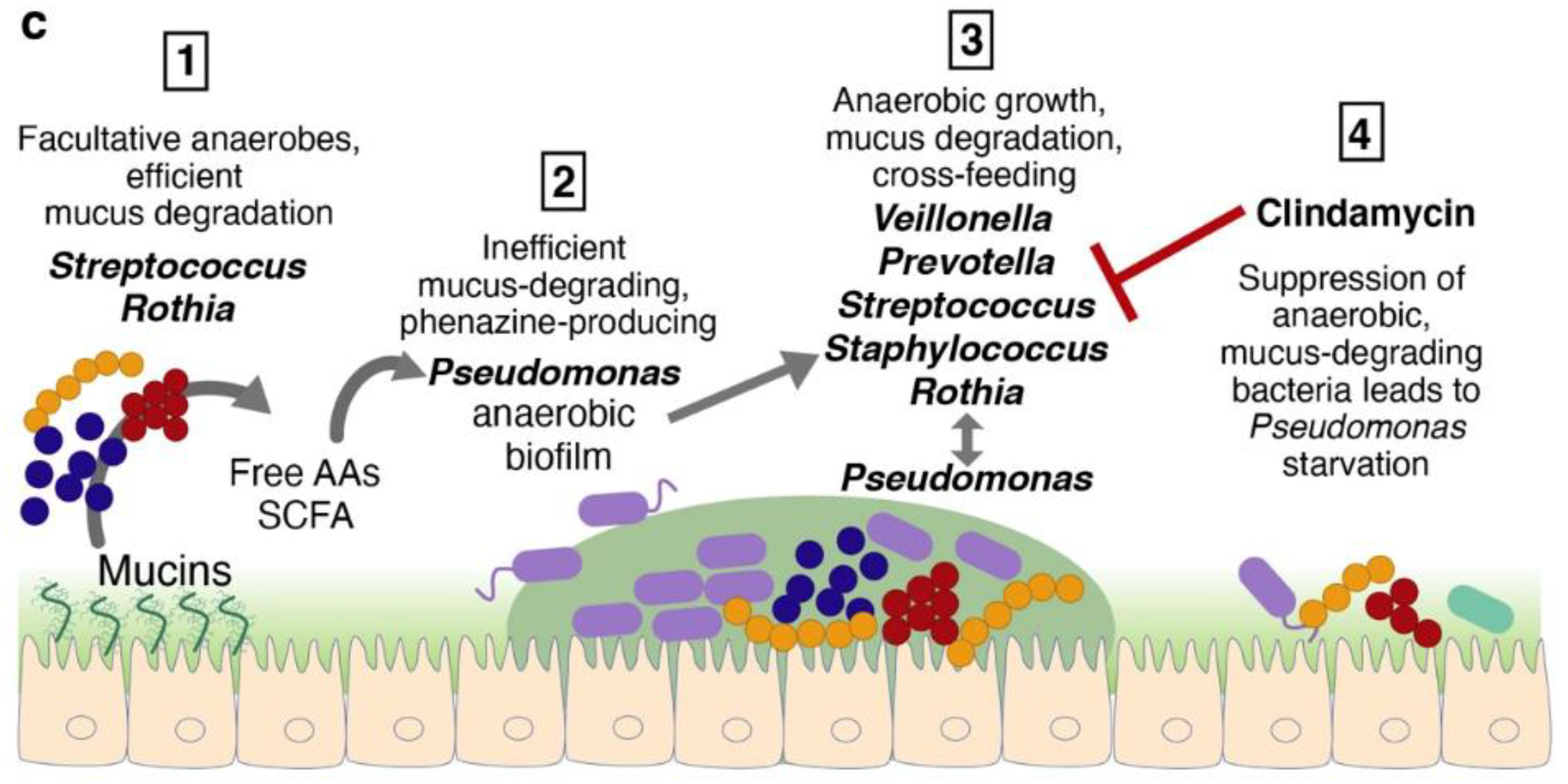MULTI-OMICS as Invaluable Tools for the Elucidation of Host–Microbe–Microbiota Interactions
Author Contributions
Funding
Conflicts of Interest
References
- Santiago-Rodriguez, T.M.; Hollister, E.B. Multi ’omic data integration: A review of concepts, considerations, and approaches. Semin. Perinatol. 2021, 45, 151456. [Google Scholar] [CrossRef] [PubMed]
- Park, C.H.; Hong, C.; Lee, A.-R.; Sung, J.; Hwang, T.H. Multi-omics reveals microbiome, host gene expression, and immune landscape in gastric carcinogenesis. iScience 2022, 25, 103956. [Google Scholar] [CrossRef] [PubMed]
- Wang, Q.; Wang, K.; Wu, W.; Giannoulatou, E.; Ho, J.W.K.; Li, L. Host and microbiome multi-omics integration: Applications and methodologies. Biophys. Rev. 2019, 11, 55–65. [Google Scholar] [CrossRef] [PubMed]
- Kashir, J.; Yaqinuddin, A. Loop mediated isothermal amplification (LAMP) assays as a rapid diagnostic for COVID-19. Med. Hypotheses 2020, 141, 109786. [Google Scholar] [CrossRef] [PubMed]
- Liao, W.; Hsu, M.; Shen, C.; Hung, K.; Cheng, C. Home Sample Self-Collection for COVID-19 Patients. Adv. Biosyst. 2020, 4, e2000150. [Google Scholar] [CrossRef] [PubMed]
- Kames, J.; Holcomb, D.D.; Kimchi, O.; DiCuccio, M.; Hamasaki-Katagiri, N.; Wang, T.; Komar, A.A.; Alexaki, A.; Kimchi-Sarfaty, C. Sequence analysis of SARS-CoV-2 genome reveals features important for vaccine design. Sci. Rep. 2020, 10, 15643. [Google Scholar] [CrossRef] [PubMed]
- Wang, F.; Kream, R.M.; Stefano, G.B. An evidence based perspective on mRNA-SARScov-2 vaccine development. Med. Sci. Monit. 2020, 26, e924700. [Google Scholar] [PubMed] [Green Version]
- Doolan, B.J.; McGrath, J.A.; Onoufriadis, A. A clinician’s guide to omics resources in dermatology. Clin. Exp. Dermatol. 2022, 47, 858–866. [Google Scholar] [CrossRef] [PubMed]
- La Barbera, L.; Macaluso, F.; Fasano, S.; Grasso, G.; Ciccia, F.; Guggino, G. Microbiome Changes in Connective Tissue Diseases and Vasculitis: Focus on Metabolism and Inflammation. Int. J. Mol. Sci. 2022, 23, 6532. [Google Scholar] [CrossRef] [PubMed]
- Purushothaman, S.; Meola, M.; Egli, A. Combination of Whole Genome Sequencing and Metagenomics for Microbiological Diagnostics. Int. J. Mol. Sci. 2022, 23, 9834. [Google Scholar] [CrossRef] [PubMed]
- Silveira, C.B.; Cobián-Güemes, A.G.; Uranga, C.; Baker, J.L.; Edlund, A.; Rohwer, F.; Conrad, D. Multi-Omics Study of Keystone Species in a Cystic Fibrosis Microbiome. Int. J. Mol. Sci. 2021, 22, 12050. [Google Scholar] [CrossRef] [PubMed]
- Breen, J.; Mur, L.A.J.; Sivakumaran, A.; Akinyemi, A.; Wilkinson, M.J.; Rodriguez Lopez, C.M. Botrytis cinerea Loss and Restoration of Virulence during In Vitro Culture Follows Flux in Global DNA Methylation. Int. J. Mol. Sci. 2022, 23, 3034. [Google Scholar] [CrossRef] [PubMed]
- Jones, K.A.; Richard, A.J.; Salbaum, J.M.; Newman, S.; Carmouche, R.; Webb, S.; Bruce-Keller, A.J.; Stephens, J.M.; Campagna, S.R. Cross-Omics Analysis of Fenugreek Supplementation Reveals Beneficial Effects Are Caused by Gut Microbiome Changes Not Mammalian Host Physiology. Int. J. Mol. Sci. 2022, 23, 3654. [Google Scholar] [CrossRef] [PubMed]



| Parameters | WGS | 16S/ITS | Shotgun Metagenomic Sequencing |
|---|---|---|---|
| Sample | Cultured or enriched microorganisms | Swabs from body sites, stool samples, body fluids or tissue samples, and sewage | Swabs from body sites, stool samples, body fluids or tissue samples fecal matter, and sewage |
| Species identification | Yes | Yes | Yes |
| Degree of resolution | Species-Strain level | Genus-Species level | Species-Strain level |
| Complete genome | Complete genome possible depending on sequencing platforms | No | Near complete to gapped genomes. |
| SNP analysis | Yes | No | Yes |
| GWAS | Yes | No | Yes |
| Identification of virulence factors and resistance genes | Yes | No | Yes |
| Microbial community profiling | No | Yes | Yes |
| Cost | $$ | $ | $$$ |
| Turnaround Time (TAT) | + | ++ | +++ |
Publisher’s Note: MDPI stays neutral with regard to jurisdictional claims in published maps and institutional affiliations. |
© 2022 by the authors. Licensee MDPI, Basel, Switzerland. This article is an open access article distributed under the terms and conditions of the Creative Commons Attribution (CC BY) license (https://creativecommons.org/licenses/by/4.0/).
Share and Cite
Toranzos, G.A.; Santiago-Rodriguez, T.M. MULTI-OMICS as Invaluable Tools for the Elucidation of Host–Microbe–Microbiota Interactions. Int. J. Mol. Sci. 2022, 23, 13303. https://doi.org/10.3390/ijms232113303
Toranzos GA, Santiago-Rodriguez TM. MULTI-OMICS as Invaluable Tools for the Elucidation of Host–Microbe–Microbiota Interactions. International Journal of Molecular Sciences. 2022; 23(21):13303. https://doi.org/10.3390/ijms232113303
Chicago/Turabian StyleToranzos, Gary A., and Tasha M. Santiago-Rodriguez. 2022. "MULTI-OMICS as Invaluable Tools for the Elucidation of Host–Microbe–Microbiota Interactions" International Journal of Molecular Sciences 23, no. 21: 13303. https://doi.org/10.3390/ijms232113303
APA StyleToranzos, G. A., & Santiago-Rodriguez, T. M. (2022). MULTI-OMICS as Invaluable Tools for the Elucidation of Host–Microbe–Microbiota Interactions. International Journal of Molecular Sciences, 23(21), 13303. https://doi.org/10.3390/ijms232113303





